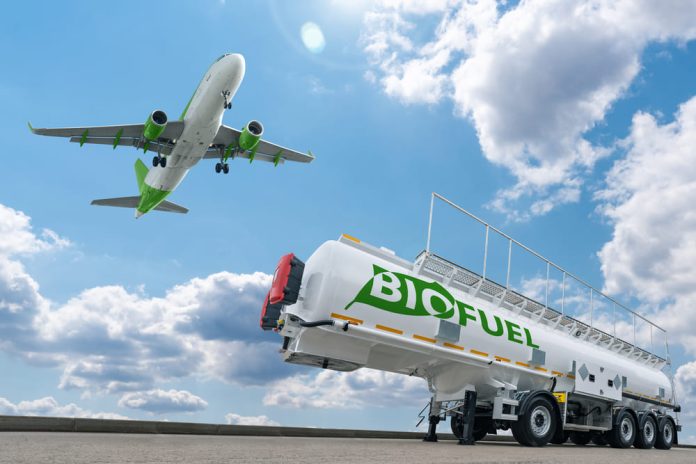Sustainability and emissions reduction are major issues in the aviation sector. There are many developments underway that will support long term commitments, but some of these are a long way off. The switch to Sustainable Aviation Fuel (SAF) is one change that is well underway, expansion in use is most likely to make a difference over the next two decades.
What is SAF?
Put most simply, Sustainable Aviation Fuel (SAF) is a fuel that is based on renewable products – anything that can be repeatedly resourced. Traditional jet fuel is a kerosene-based fuel, a non-renewable fossil fuel.
Sources of SAF can be anything that meets this requirement of being a renewable hydrocarbon source. Current popular choices include cooking oils (and other fats and oils), biomass, and waste products. Work is underway in several other areas too, including synthetic production of hydrocarbons.
These sources are collected, mixed, and refined to produce fuel. The industry is currently focussed on producing so-called “drop-in” biofuels. This means they can easily be mixed with conventional jet fuel. The resulting blended fuel is then tested and certified for use as jet fuel. Currently this blending is done at ratios up to 50%, but often much lower. Test flights have been made by several operators using 100% SAF and it is likely the industry will move this way with time.
Critically, blended SAF can be used in existing jet engines without modification. It can also use existing fuel storage, supply, and distribution infrastructure. This is not something that can be said for electric or hydrogen, and is a major complication in the adoption of these sources.
Expanding in use
The first use of SAF in test flights was in 2008, with UK airline Virgin Atlantic. Commercial use has been allowed since 2011, with strict regulations on the fuel composition and blended amounts. UK and European airlines initially led the way, but US airlines are well onboard now (with United Airlines being the first of the major US airlines to operate with SAF, in 2019).
Since then, usage has increased significantly, with more and more airlines announcing SAF use in their flight planning routes. Many have chosen to make it part of their marketing and branded – very important in an increasingly green focussed world.
In terms of total usage, in 2019 airlines were using 40 million litres of SAF (against total jet fuel use of 432 billion litres). This increased in 2020 to 80 million litres, and to 120 million litres in 2021. Use is widely expected to grow significantly in the coming years. Looking further ahead, ICAO predicted in 2019 that SAF use would reach 8 billion litres by 2032. IATA shares this view, with the prediction that SAF will make up 2% of total fuel use by 2030.
Airlines and manufacturers continue to take expansion very seriously. Boeing, as just one example, has committed to have all its aircraft certified to fly on 100% sustainable aviation fuels by 2030. Airbus already has all aircraft certified to fly on 50% blended SAF and is also working to move this to 100% by 2030.
Major role to play in carbon commitments
There are many developments underway to help meet the aviation industry’s commitment to reach net zero carbon by 2050. Major changes such as switching to electric and hydrogen propulsion will ultimately make a difference, but not for decades. Speaking about this in 2021, Boeing’s CEO David Calhoun said that SAF is the only answer to the commitments for 2050.
Looking wider at the whole production and supply chain is important too, not just direct carbon dioxide emissions. Producing feedstock specifically for SAF use will also lead to carbon dioxide absorption. BP claims that total lifecycle carbon emissions can be reduced by up to 80%.
SAF is not without its challenges though. Most significantly, it is currently more expensive than traditional fuel – around double the price. This is, of course, often a problem with new products or technology. It will likely improve over time as fuel usage increases and production technology improves. Manufacturer CFM International has shared some interesting research in this area. It believes that when the rising jet fuel price and other carbon charges are factored in, SAF and jet fuel costs will be equal by 2037.
Final Thoughts
SAF is well on the way to mainstream use in aviation. Infrastructure and fuel availability at airports are improving, and government and private sector initiatives are supporting a reduction in price. With major commitment from the industry on carbon reduction, SAF will play an increasingly important role over the coming decades.
References:
- CFM claims, and past SAF volumes: https://simpleflying.com/saf-cost-competitive-jet-fuel/
- Total fuel use volumes: https://www.statista.com/statistics/655057/fuel-consumption-of-airlines-worldwide/
- BP emissions claim: https://www.bp.com/en/global/air-bp/news-and-views/views/what-is-sustainable-aviation-fuel-saf-and-why-is-it-important.html



































































